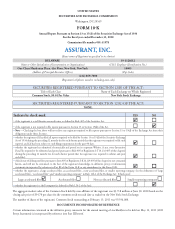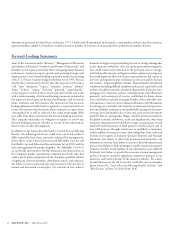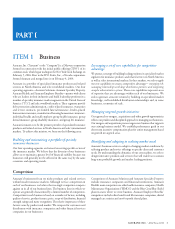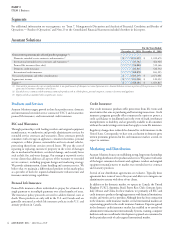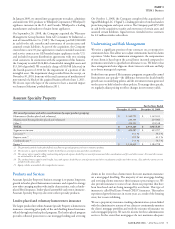Assurant 2010 Annual Report Download - page 17
Download and view the complete annual report
Please find page 17 of the 2010 Assurant annual report below. You can navigate through the pages in the report by either clicking on the pages listed below, or by using the keyword search tool below to find specific information within the annual report.11ASSURANT, INC. 2010 Form 10K
PART I
ITEM 1 Business
Dividend Payment Limitations
e Company’s assets consist primarily of the capital stock of our
subsidiaries. Accordingly, our future cash fl ows depend upon the
availability of dividends and other statutorily permissible payments
from our subsidiaries. e ability to pay such dividends and to make
such other payments is regulated by the states in which our subsidiaries
are domiciled. ese dividend regulations vary from state to state and
by type of insurance provided by the applicable subsidiary, but generally
require our insurance subsidiaries to maintain minimum solvency
requirements and limit the amount of dividends these subsidiaries can
pay to the holding company. For more information, please see Item 7,
“Management’s Discussion and Analysis of Financial Condition and
Results of Operations—Liquidity and Capital Resources—Regulatory
Requirements.”
Risk Based Capital Requirements
In order to enhance the regulation of insurer solvency, the NAIC has
established certain risk-based capital standards applicable to life, health
and property and casualty insurers. Risk-based capital, which regulators
use to assess the suffi ciency of an insurer’s statutory capital, is calculated
by applying factors to various asset, premium, claim, expense and reserve
items. Factors are higher for items which in the NAIC’s view have greater
underlying risk. e NAIC periodically reviews the risk-based capital
formula and changes to the formula could occur in the future.
Investment Regulation
Insurance company investments must comply with applicable laws
and regulations that prescribe the kind, quality and concentration
of investments. ese regulations require diversifi cation of insurance
company investment portfolios and limit the amount of investments
in certain asset categories.
Financial Reporting
Regulators closely monitor the fi nancial condition of licensed insurance
companies and our insurance subsidiaries are required to fi le periodic
fi nancial reports with insurance regulators. Moreover, states regulate the
form and content of these statutory fi nancial statements.
Products and Coverage
Insurance regulators have broad authority to regulate many aspects of our
products and services. For example, some jurisdictions require insurers
to provide coverage to persons who would not be considered eligible
insurance risks under standard underwriting criteria, dictating the types
of insurance and the level of coverage that must be provided to such
applicants. Additionally, certain non-insurance products and services,
such as service contracts, may be regulated by regulatory bodies other
than departments of insurance.
Pricing and Premium Rates
Nearly all states have insurance laws requiring insurers to fi le price
schedules and policy forms with the state’s regulatory authority. In many
cases, these price schedules and/or policy forms must be approved prior
to use, and state insurance departments have the power to disapprove
increases or require decreases in the premium rates we charge.
Market Conduct Regulation
Activities of insurers are highly regulated by state insurance laws
and regulations, which govern the form and content of disclosure to
consumers, advertising, sales practices and complaint handling. State
regulatory authorities enforce compliance through periodic market
conduct examinations.
Guaranty Associations and Indemnity Funds
Most states require insurance companies to support guaranty associations
or indemnity funds, which are established to pay claims on behalf of
insolvent insurance companies. ese associations may levy assessments
on member insurers. In some states member insurers can recover a portion
of these assessments through premium tax off sets and/or policyholder
surcharges.
Insurance Regulatory Initiatives
e NAIC and state insurance regulators have considered and are
considering various proposals that may alter or increase state authority to
regulate insurance companies and insurance holding companies. Please
see Item 1A, “Risk Factors—Risks Related to Our Industry—Changes
in regulation may reduce our profi tability and limit our growth” for a
discussion of the risks related to such initiatives.
Federal Regulation
Patient Protection and Aff ordable Care Act
Although health insurance is generally regulated at the state level,
recent legislative actions were taken at the federal level that impose
added restrictions on our business, in particular Assurant Health and
Assurant Employee Benefi ts. In March 2010, President Obama signed
the Aff ordable Care Act into law. Provisions of the Aff ordable Care Act
and related reforms have and will become eff ective at various dates over
the next several years and will make sweeping and fundamental changes
to the U.S. health care system that are expected to signifi cantly aff ect
the health insurance industry. Although we cannot predict or quantify
the precise eff ects of the Aff ordable Care Act on our business, they will
include, in particular, a requirement that we pay rebates to customers
if the loss ratios for some of our products lines are less than specifi ed
percentages; the need to reduce commissions, and the consequent risk that
insurance producers may sell less of our products than they have in the
past; changes in the benefi ts provided under some of our products; limits
on lifetime and annual benefi t maximums; a prohibition from imposing
any pre-existing condition exclusion as it applies to enrollees under the
age of 19 who apply for coverage; limits on our ability to rescind coverage
for persons who have misrepresented or omitted material information
when they applied for coverage and, after January 1, 2014, elimination of
our ability to underwrite health insurance products with certain narrow
exceptions; a requirement to off er coverage to any person who applies
for such coverage; increased costs to modify and/or sell our products;
intensifi ed competitive pressures that limit our ability to increase rates
due to state insurance exchanges; signifi cant risk of customer loss; new
and higher taxes and fees; and the need to operate with a lower expense
structure at both the business segment and enterprise level.


